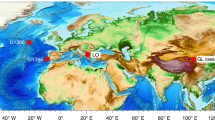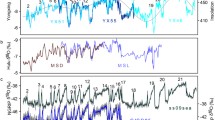Abstract
The study demonstrates that the orbital climatic diagram (OCD) built on the basis of the simplified and general concepts of mechanisms for climatic response to orbital forcing can be a reasonable alternative to Milankovitch’s and his followers’ discrete insolation curves, which are widely used in paleoclimate interpretations. Comparison of the OCD and the oxygen isotope record LR04 indicates a fairly good match (considering the simplicity of the OCD construction and interpretation) in 0–1240 ka. The study discusses some discrepancies in the chronology and structure of the LR04 and OCD. It was shown that climate response may differ from that predicted by orbital insolation forcing on the basis of the generally accepted mechanisms causing transformation of orbital signals. It was shown that a shift from a dominant glacial periodicity of 41 to 100 k.y. (Middle Pleistocene transition) took place at ∼1240 ka. Since then, the 100-k.y. eccentricity cycle has not been interrupted. Therefore, strictly speaking, the revised numbering of marine isotope stages (MIS) should be adopted for the interval of 1240-900 ka to reflect realistic 100-k.y. cycles instead of 41-k.y. cycles, similar to the interval of 900–100 ka.
Similar content being viewed by others
References
Bassinot, F.C., Labeyrie, L.D., Vincent, E., et al., The astronomical theory of climate and the age of the Brunhes-Matuyama magnetic reversal, Earth Planet. Sci. Lett., 1994, vol. 126, pp. 91–108.
Berger, A.L. and Loutre, M.F., Insolation values for the climate of the last 10 million years, Quatern. Sci. Rev., 1991, vol. 10, pp. 297–317.
Berger, A., Loutre, M., and Melice, J., Milankovitch and beyond, in Paleoclimate and the Earth Climate System: Milutin Milankovitch Anniversary Symp. Abstr., Belgrade: Serbian Acad. Sci. Arts, 2004, pp. 31–50.
Bintanja, R. and van de Wal, R.S.W., North American icesheet dynamics and the onset of 100000-years glacial cycles, Nature, 2008, vol. 454, pp. 869–872.
Bol’shakov, V.A. and Bol’shakov, P.V., Astronomic paleoclimate theory—a new concept, Stratigr. Geol. Correl., 1999, vol. 7, no. 6, pp. 3–13.
Bol’shakov, V.A., On the depth of paleomagnetic record acquisition by deep-sea sediments with reference to the climatic-stratigraphic position of the Matuyama-Bryunes reversal, Fiz. Zemli, 1999, no. 6, pp. 93–96.
Bol’shakov, V.A., New way for plotting diagram of the paleoclimatic changes in the Pleistocene, Dokl. Akad. Nauk. Ser. Geogr., 2000, vol. 374, no. 5, pp. 692–695.
Bol’shakov, V.A., Novaya kontseptsiya orbital’noi teorii paleoklimata (New Concept of the Orbital Paleoclimate Theory), Moscow: MGU, 2003b [in Russian].
Bol’shakov, V.A., New way of chronometerizing oxygen isotope records of deep-sea sediments, Dokl. Akad. Nauk, 2003a, vol. 388, no. 1, pp. 105–108.
Bol’shakov, V.A., Ivanova, E.V., and Prudkovskii, A.G., Applying a new method for timing paleoclimatic deep-sea sedimentary records, Oceanology, 2005, vol. 45, no. 6, pp. 916–926.
Bol’shakov, V.A., Correlation of continental and deep-sea deposits of the Pleistocene: formulation of the question and some problems, Izv. Akad. Nauk, Ser. Geogr., 2006, no. 4, pp. 16–28.
Bol’shakov, V.A., How long will the “precession epoch” last in terms of Pleistocene glacial cycles?, Rus. J. Earth Sci., 2008, vol. 10, ES3004. doi: 10.2205/2008ES000299
Bol’shakov, V.A., The astrochronological method of dating paleogeographyical events, in Metody paleogeograficheskikh rekonstruktsii. Metod. posobie (Methods of Paleogeographical Reconstructions: A Methodological Handbook), Kaplin, P.A. and Yanin, T.A., Eds., Moscow: Izd-vo MGU, 2010, pp. 289–307.
Bol’shakov, V.A., The problem of the 11th marine isotope stage from the viewpoint of the new conception of the orbital theory of the paleoclimate, Okeanologiya, 2010a, vol. 50, no. 2, pp. 236–247.
Bol’shakov, V.A. and Kapitsa, A.P., Lessons of the development of the orbital theory of paleoclimate, Vestn. Ross. Akad. Nauk, 2011, vol. 81, no. 7, pp. 603–612.
Bol’shakov, V.A., The orbital climatic diagram as an alternative to the use of discrete insolation curves for paleoclimatic interpretations and correlation, Byull. Kom. po Izuch. Chetvertichnogo Perioda, 2012a, vol. 83, pp. 95–103.
Bol’shakov, V.A., The comparison of the orbital-climatic diagram with the benthic oxygen isotope stack LR04 for investigation of the middle Pleistocene transition, in Proc. 9th Int. Conf. “Problems of Geocosmos,” 2012b, pp. 203–208.
Bol’shakov, V.A., Kapitsa, A.P., and Rees, W.G., James Croll: a scientist ahead of his time, Polar Rec., 2012, vol. 48, no. 2, pp. 201–205.
Bol’shakov, V.A., An answer to I.I. Smul’skii’s criticism, Vestn. Ross. Akad. Nauk, 2013a, vol. 83, no. 1, pp. 40–44.
Bol’shakov, V.A., Study of parameters of the Middle Pleistocene transition by comparison of the oxygen-isotope record LR04 with the orbital-climatic diagram, Dokl. Akad. Nauk, 2013b, vol. 449, no. 3, pp. 338–341.
Cande, S.C. and Kent, D.V., Revised calibration of the geomagnetic polarity timescale for the late Cretaceous and Cenozoic, J. Geophys. Res., 1995, vol. 100, no. B4, pp. 6093–6095.
Clark, P.U., Archer, D., Pollard, D., et al., The middle Pleistocene transition: characteristics, mechanisms, and implications for long-term changes in atmospheric pCO2, Quarter. Sci. Rev., 2006, vol. 25, pp. 3150–3184.
Croll, J., Climate and Time in Their Geological Relations: A Theory of Secular Changes of the Earth’s Climate, London: Edward Stanford, 1875.
Emiliani, C., Quaternary hypsithermals, Quaternary Res., 1972, vol. 2, pp. 270–273.
EPICA community members, Eight glacial cycles from an Antarctic ice core, Nature, 2004, vol. 429, pp. 623–628.
de Garidel-Thoron, T., Rosenthal, Y., Bassinot, F., and Beaufort, L., Stable sea surface temperatures in the western Pacific warm pool over the past 1.75 million years, Nature, 2005, vol. 433, pp. 295–298.
GRIP members, Climate instability during the last interglacial period recorded in the GRIP ice core, Nature, 1993, vol. 364, pp. 203–207.
Hays, J.D., Imbrie, J., and Shackleton, N., Variation in the Earth’s orbit: pacemaker of the ice ages, Science, 1976, vol. 194, pp. 1121–1132.
Head, M.J., Pillans, B., and Farguhar, S.A., The early-middle Pleistocene transition: characterization and proposed guide for the defining boundary, Episodes, 2008, vol. 31, no. 2, pp. 255–259.
Huybers, P. and Wunsch, C., A depth-derived Pleistocene age model: uncertainty estimates, sedimentation variability, and nonlinear climate change, Paleoceanol., 2004, vol. 19, PA 1028.
Imbrie, J. and Imbrie, K.P., Ice Ages: Solving the Mystery, Cambridge, Massachusetts: Harvard Univ. Press, 1979.
Imbrie, J., Hays, J., Martinson, D., et al., The orbital theory of Pleistocene climate: support from a revised chronology of the marine δ18O record, in Milankovitch and Climate, Berger, A.L. et al., Eds., NATO ASI Ser. C. 126, Dordrecht: Reidel, 1984, pp. 269–305.
Imbrie, J., Berger, A., Boyle, A., et al., On the structure and origin of major glaciation cycles. 2. The 100000-year cycle, Paleoceanogr., 1993, vol. 8, pp. 699–735.
Jouzel, J., Masson-Delmotte, V., Cattani, O., et al., Orbital and millennial Antarctic climate variability over the past 800000 years, Science, 2007, vol. 317, pp. 793–796.
Karabanov, E.B., Prokopenko, A., Kuz’min, M.I., et al., Glacial and interglacial periods of Siberia: paleoclimate record of Lake Baikal and correlation with West Siberian correlation scheme, Geol. Geofiz., 2001, nos. 1–2, pp. 48–63.
Karner, D.B., Levine, J., Medeiros, B.P., and Muller, R.A., Constructing a stacked benthic δ18O record, Paleoceanogr., 2002, vol. 17, no. 3, PA 1030. doi: 10.1029/2001PA000667
Lisiecki, L.E. and Raymo, M.E., A Pliocene-Pleistocene stack of 57 globally distributed benthic δ18O records, Paleoceanogr., 2005, vol. 20, PA 1030. doi: 10.1029/2004PA001071
Lisiecki, L. and Raymo, M., Plio-Pleistocene evolution: trends and transitions in glacial cycle dynamics, Quatern. Sci. Rev., 2007, vol. 26, pp. 56–69.
Lisiecki, L.E., Links between eccentricity forcing and the 100000-year glacial cycle, Nature Geosci., 2010, vol. 3, pp. 349–352.
Loutre, M.F., Paillard, D., Vimeix, F., and Cortijo, E., Does mean annual insolation have the potential to change the climate?, Earth Planet. Sci. Lett., 2004, vol. 221, pp. 1–14.
Markov, K.K., On the content of concepts of “glacial epoch” and “interglacial epoch,” in Markov K.K. Izbrannye trudy. Paleogeografiya i noveishie otlozheniya (Markov, K.K. Selected Works. Paleogeography and the Most Recent Deposits), Moscow: Nauka, 1986, pp. 25–30.
de Menocal, P.B., Ruddiman, W.F., and Kent, D.V., Depth of post-depositional remanence acquisition in deep-sea sediments: a case study of the Brunhes-Matuyama reversal and oxygen isotopic stage 19.1, Earth Planet. Sci. Lett., 1990, vol. 99, pp. 1–13.
Milankovitch, M., Mathematische Klimalehre und Astronomische Theorie der Klimaschwankungen, Berlin: Gebruder Borntraeger, 1930.
Petit, J., Jouzel, J., Raynaud, D., et al., Climate and atmospheric history of the past 420000 years from the Vostok ice core, Antarctica, Nature, 1999, vol. 399, pp. 429–436.
Pisias, N.G. and Moore, T.C., The evolution of the Pleistocene climate: a time series approach, Earth Planet. Sci. Lett., 1981, vol. 52, pp. 450–458.
Prell, W.L., Imbrie, J., Martinson, D.G., et al., Graphic correlation of oxygen isotope stratigraphy application to the late Quaternary, Paleoceanography, 1986, vol. 1, no. 2, pp. 137–162.
Ruddiman, W.F., Raymo, M., and McIntyre, A., Matuyama 41000-year cycles: north Atlantic ocean and Northern Hemisphere ice sheets, Earth Planet. Sci. Lett., 1986, vol. 80, pp. 117–129.
Schneider, D.A., Kent, D.V., and Mello, G.A., A detailed chronology of the Australasian impact event, the Brunhes-Matuyama geomagnetic polarity reversal, and global climate change, Earth Planet. Sci. Lett., 1992, vol. 111, pp. 395–405.
Shackleton, N.J., Berger, A., and Peltier, W., An alternative astronomical calibration of the lower Pleistocene time scale based on ODP Site 677, Trans. R. Soc. Edinb., 1990, vol. 81, pp. 251–261.
Shackleton, N., New data on the evolution of Pliocene climatic stability, in Paleoclimate and Evolution with Emphasis on Human Origins, Vrba, E.S., et al., Eds., Yale Univ. Press, 1995, pp. 242–248.
Spell, T. and McDougall, I., Revisions to the age of the Brunhes-Matuyama boundary and the Pleistocene geomagnetic polarity timescale, Geophys. Rev. Lett., 1992, vol. 19, pp. 1181–1184.
Tauxe, L., Herbert, T., Shackleton, N., and Kok, Y., Astronomical calibration of the Matuyama-Brunhes boundary: consequences for magnetic remanence acquisition in marine carbonates and Asian loess sequences, Earth Planet. Sci. Lett., 1996, vol. 140, pp. 133–146.
Thompson, W.G. and Goldstein, S.L., A radiometric calibration of the SPECMAP timescale, Quatern. Sci. Rev., 2006, vol. 25, nos. 23–24, pp. 3207–3215.
Velichko, A.A., Global climate change and reaction of the landscapes, Izv. Akad. Nauk SSSR, Ser. Geograf., 1991, no. 5, pp. 5–22.
Velichko, A.A., Middle Valdai, Zyryan-Sartan megainterval and climatic rank of its optimum, in Fundamental’nye problemy kvartera: itogi izucheniya i osnovnye napravleniya dal’neishikh issledovanii. Mat. VI Vseross. sovesh. po izucheniyu chetvertichnogo perioda (Proc. VI All-Rus. Quaternary Conf. “Fundamental Problems of the Quaternary: Results and Trends of Further Research”), Novosibirsk: Izd-vo SO RAN, 2009b, pp. 107–109.
Winograd, I.J., Coplen, T., Landwehr, J., et al., Continuous 500000-year climate record from vein calcite in Devils Hole, Nevada, Science, 1992, vol. 258, pp. 255–260.
Author information
Authors and Affiliations
Corresponding author
Additional information
Original Russian Text © V.A. Bol’shakov, 2014, published in Stratigrafiya. Geologicheskaya Korrelyatsiya, 2014, Vol. 22, No. 5, pp. 97–112.
Rights and permissions
About this article
Cite this article
Bol’shakov, V.A. A link between global climate variability in the Pleistocene and variations in the Earth’s orbital parameters. Stratigr. Geol. Correl. 22, 538–551 (2014). https://doi.org/10.1134/S0869593814050049
Received:
Accepted:
Published:
Issue Date:
DOI: https://doi.org/10.1134/S0869593814050049




